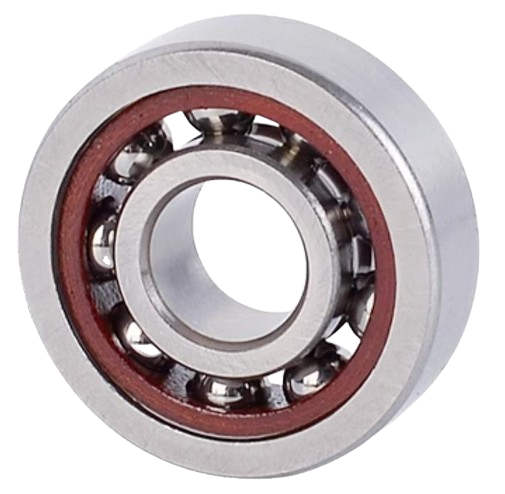Miniature Angular Contact Ball Bearings
Miniature Angular Contact Ball Bearings are compact, high-precision components engineered to support both radial and axial loads simultaneously. Their unique design and performance make them ideal for space-constrained, high-speed, and vibration-sensitive applications such as robotics, power tools, and precision instruments.
What Are Miniature Angular Contact Ball Bearings?
Miniature angular contact ball bearings are a specialized type of ball bearing featuring a defined contact angle between the inner and outer rings and the rolling elements (typically steel balls). This contact angle allows the bearing to efficiently handle combined radial and axial loads, even under high-speed or high-stress conditions. Their compact structure makes them particularly suitable for precision applications where space, vibration control, and dynamic stability are critical.
Structural Features
The typical structure of a miniature angular contact bearing includes:
- Inner and Outer Rings: Shaped with conical surfaces that intersect at the bearing center.
- Rolling Elements: Usually precision steel balls that roll between the rings.
- Cage: Commonly made of steel or engineering plastic to separate and guide the rolling elements.
This tapered design allows for optimal load distribution, enhancing both rigidity and load-bearing capacity in compact environments.
Working Principle
These bearings operate based on rolling friction. When a load is applied, the balls rotate between the inner and outer rings, transferring force efficiently. The predefined contact angle enables the bearing to endure axial forces in addition to radial loads. Generally, the greater the contact angle, the higher the axial load capacity.
Performance Characteristics
- High Load Capacity: Handles both radial and axial loads effectively.
- High-Speed Capability: Designed for minimal rolling resistance and high RPM applications.
- Precision and Stiffness: Maintains dimensional stability under stress, crucial for accurate operations.
- Low Friction: Rolling contact reduces energy loss and heat generation compared to sliding bearings.
- Extended Service Life: With proper lubrication and maintenance, these bearings offer excellent durability.
Applications
Miniature angular contact ball bearings are commonly used in high-precision and small-format mechanical systems, such as:
- Machine Tools: Enhancing spindle precision and ball screw support for better accuracy and stability.
- Wheel Loaders: Providing durability under high radial and axial loads in compact construction machinery.
- High-Speed Power Tools: Supporting fast and accurate operation while minimizing vibration.
- Automotive Transmissions: Ensuring efficiency and reliability in compact transmission systems.
- Robotics: Improving joint flexibility and motion precision in lightweight robot arms and actuators.
Conclusion
Miniature angular contact ball bearings combine small size with high-performance characteristics, making them an essential component in modern industrial and automation systems. Their ability to withstand complex load conditions while maintaining high precision and long service life positions them as a reliable solution for demanding applications across various sectors.
FAQs: Miniature Angular Contact Ball Bearings
1. What is the typical contact angle in miniature angular contact bearings?
The contact angle usually ranges from 15° to 30°, depending on the bearing design. Larger contact angles offer higher axial load capacity.
2. Can these bearings be used in pairs?
Yes. Miniature angular contact bearings can be arranged in pairs or sets (DB, DF, DT) to accommodate specific load and rigidity requirements.
3. How often should these bearings be lubricated?
Lubrication frequency depends on the application speed, temperature, and load. In high-speed applications, oil-air or oil-mist lubrication is often preferred.
4. Are these bearings suitable for cleanroom environments?
Yes. Certain models are available in cleanroom-compatible variants with low particle emission and special lubricants.
Installation & Maintenance Tips
- Handle with care: Avoid direct impact or force during mounting to prevent raceway damage.
- Proper alignment: Ensure shafts and housings are precisely aligned to prevent preload imbalance or noise.
- Clean environment: Install in a clean, dry space to avoid contamination from dust or debris.
- Torque control: Apply the recommended torque during assembly to avoid over-stressing the bearing.
- Regular inspection: Monitor noise, vibration, and temperature regularly for early signs of wear.
Selection Guide: How to Choose the Right Miniature Angular Contact Bearing
- Load direction: Determine whether the application requires axial, radial, or combined load handling.
- Speed requirements: Choose based on the maximum RPM of your application. Higher speeds may require ceramic balls or hybrid designs.
- Contact angle: Select a larger contact angle for higher axial loads, and smaller for radial-dominated applications.
- Preload options: Select light, medium, or heavy preload based on desired stiffness and axial rigidity.
- Lubrication method: Choose grease for low to moderate speeds; oil systems for high-speed or thermally sensitive environments.
For OEM or customized solutions, consult with a bearing specialist to match specific dimensional or performance criteria.
Showing 1–15 of 46 results

